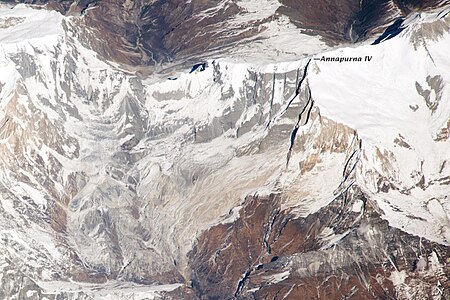Annapurna IV
| Annapurna IV | |
|---|---|
 Annapurna IV is the peak the farthest to the left in this image. | |
| Highest point | |
| Elevation | 7,525 m (24,688 ft) |
| Prominence | 255 m (837 ft) |
| Parent peak | Annapurna I |
| Isolation | 3.81 km (2.37 mi) |
| Coordinates | 28°32′15″N 84°4′58″E / 28.53750°N 84.08278°ECoordinates: 28°32′15″N 84°4′58″E / 28.53750°N 84.08278°E |
| Geography | |
 Annapurna IV | |
| Parent range | [[Annapurna]] Himal |
| Climbing | |
| First ascent | 1955 |
| Easiest route | snow/ice climb |
Annapurna IV (Nepali: अन्नपूर्ण ४) is a mountain of the Annapurna mountain range in the Himalayas which is located in Nepal. Along with the taller Annapurna II, it is isolated from the other peaks in the range via a major col. It is the 4th highest peak of the range. It was first climbed in 1955 by a German expedition led by Heinz Steinmetz via the North Face and Northwest Ridge. The summit party comprised Steinmetz, Harald Biller, and Jürgen Wellenkamp.
Features[]
Despite its low prominence, Annapurna IV is an important peak relative to its immediate neighbors. The standard route of ascent for Annapurna II uses the North face of this peak to ascend to the ridge that connects the two summits, thus circumventing many of the hazards faced on that mountain. To the West, Annapurna IV drops away steeply into a major col, from which then rises the famous Southeast ridge of Annapurna III. Although subject to decades of attempts, the ridge was only successfully climbed for the first time in 2021.
Rockfalls[]
Rockfalls from Annapurna IV are thought to have blocked the Seti River, creating a temporary dam.[1]

Annapurna IV

The rockfall that temporarily blocked the river[1]
See also[]
- Annapurna II
- Annapurna I Main
- Annapurna I Central
- Annapurna I East
- Annapurna III
References[]
- ^ a b "Making Sense of Nepal's Seti River Disaster : Image of the Day". earthobservatory.nasa.gov. 22 December 2013. Retrieved 6 March 2020.
- Seven-thousanders of the Himalayas
- Mountains of the Gandaki Province
- Nepal mountain stubs


